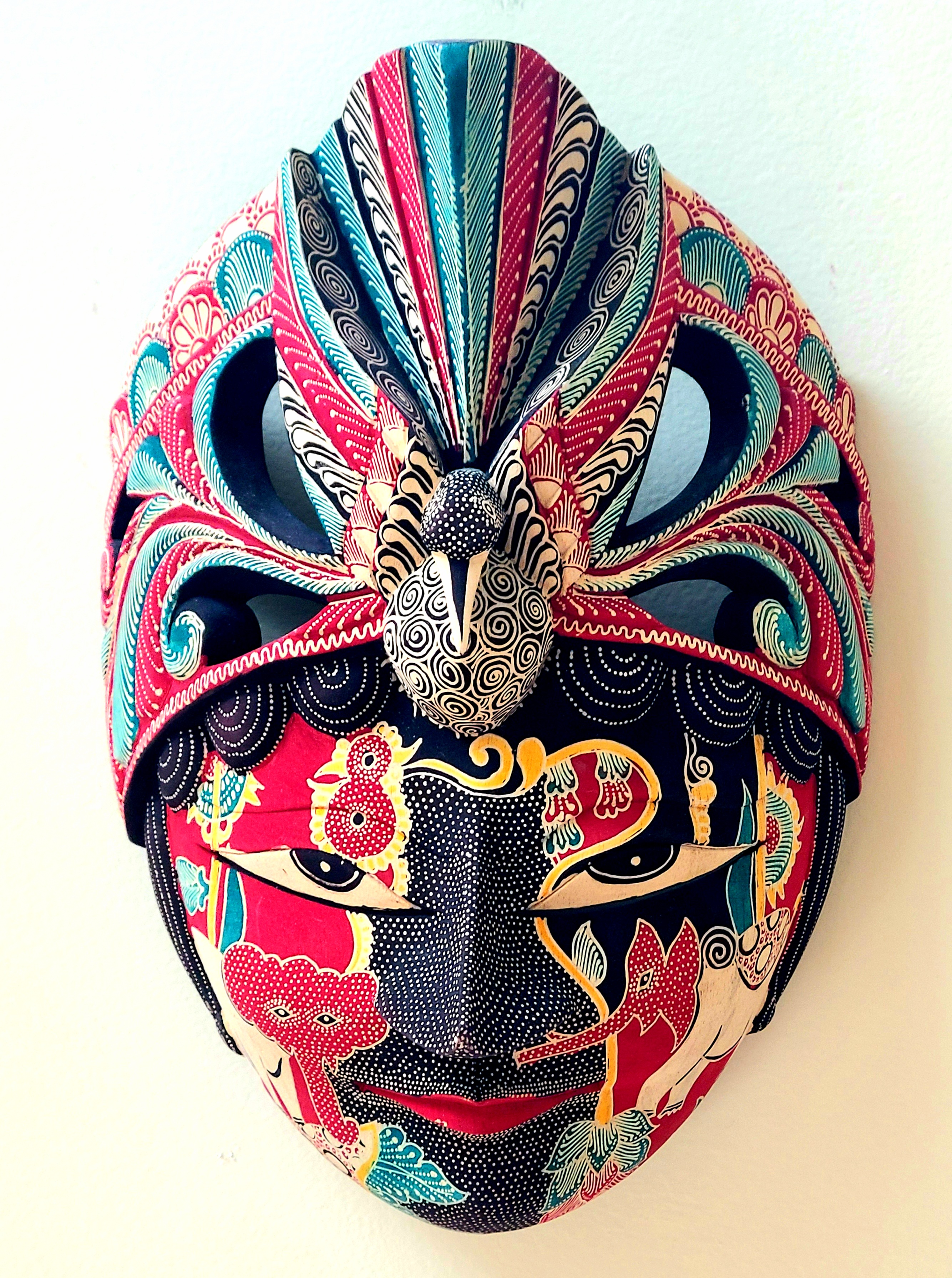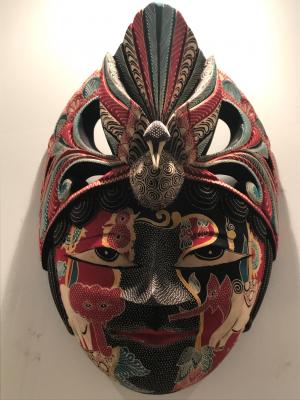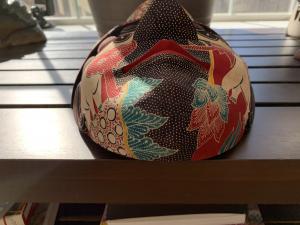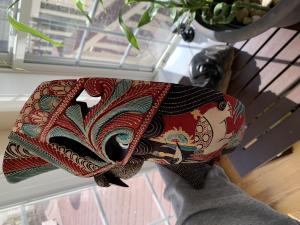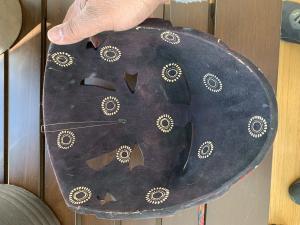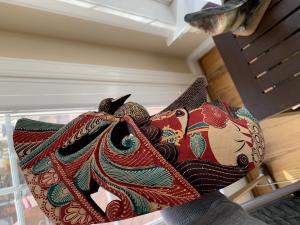Princess Candra Kirana Mask
Masks
25 sept. 2016
Wooden mask adorned with batik, featuring a female face in the headdress with a peacock.
Javanese masks are used in performing the tales of Panji, which are inspired by stories of Javanese cultural hero Prince Panji Inu Kertapati that date back to the 13th century. The masks depict different characters in the story, such as Gunung Sari, Kundana Warso, Klana Sewandana and Panji Semirang. The traditional tari topeng Panji (Panji mask dance) and tari topeng Penthul Tembem (Penthul Tembem mask dance) are usually performed during traditional ceremonies in the Gunungkidul area, such as during sea-offering rituals and sacred prayers.
This mask represents Candra Kirana from the tales of Panji and the stories about her. She was the princess of the ancient city of Daha.
Candra Kirana is often depicted wearing a merak (peacock) cap. Elephants on the face of the mask symbolize the story from the Cekel Waneng Pati, a well-known Panji story. Ratu Panggala Jawa’s requested to marry Candra Kirana. In response, Sandra Kirana set him a number of conditions, one of which was to give her two white elephants. He refused to comply with her requests and attacked the city of Daha. Inu came to help and the attack failed. It was now Inu’s turn to ask for Candra’s hand. She laid out to him the same conditions. Inu was gifted two elephants by Carang Tinangluh when he helped him by killing a giant and married Candra Kirana.
In another Panji story, Raden Inu Kartopati is betrothed to princess Candra Kirana, worsening an already difficult relationship between her and her sister. Candra Kirana assumes the identity of Panji Semirang when she flees from the royal palace, driven away by her sister and followers, who scheme against her, accusing her of plotting against her father. As Panji Semirang, she establishes a new kingdom and develops a reputation as a brave warrior with myriad followers who do not know her true identity. She encounters Raden Inu Kartopati in battle, and they fall in love, though he does not know Panji is actually Candra Kirana. The story continues with many twists and turns until eventually Panji and Raden Inu meet again and she reveals her true identity so they can be together forever
Wooden mask adorned with batik, featuring a female face in the headdress with a peacock.
Javanese masks are used in performing the tales of Panji, which are inspired by stories of Javanese cultural hero Prince Panji Inu Kertapati that date back to the 13th century. The masks depict different characters in the story, such as Gunung Sari, Kundana Warso, Klana Sewandana and Panji Semirang. The traditional tari topeng Panji (Panji mask dance) and tari topeng Penthul Tembem (Penthul Tembem mask dance) are usually performed during traditional ceremonies in the Gunungkidul area, such as during sea-offering rituals and sacred prayers.
This mask represents Candra Kirana from the tales of Panji and the stories about her. She was the princess of the ancient city of Daha.
Candra Kirana is often depicted wearing a merak (peacock) cap. Elephants on the face of the mask symbolize the story from the Cekel Waneng Pati, a well-known Panji story. Ratu Panggala Jawa’s requested to marry Candra Kirana. In response, Sandra Kirana set him a number of conditions, one of which was to give her two white elephants. He refused to comply with her requests and attacked the city of Daha. Inu came to help and the attack failed. It was now Inu’s turn to ask for Candra’s hand. She laid out to him the same conditions. Inu was gifted two elephants by Carang Tinangluh when he helped him by killing a giant and married Candra Kirana.
In another Panji story, Raden Inu Kartopati is betrothed to princess Candra Kirana, worsening an already difficult relationship between her and her sister. Candra Kirana assumes the identity of Panji Semirang when she flees from the royal palace, driven away by her sister and followers, who scheme against her, accusing her of plotting against her father. As Panji Semirang, she establishes a new kingdom and develops a reputation as a brave warrior with myriad followers who do not know her true identity. She encounters Raden Inu Kartopati in battle, and they fall in love, though he does not know Panji is actually Candra Kirana. The story continues with many twists and turns until eventually Panji and Raden Inu meet again and she reveals her true identity so they can be together forever
Height: 13”
Width: 9”
Depth: 6”
inches
Solo, Java, Indonesia
Solo, Java, Indonesia
Technique: batik on carved wooden mask
The mask is carved of pule wood and adorned with batik techniques featuring traditional motifs including feathers and dots.
Colors: red, black, white, green, and yellow.
Batik (in Javanese means “to dot”) is the ancient technique of painting with hot liquid wax, then dyeing it. Canting (a pen filled with hot liquid wax) and hot dark wax are used to make designs. First, painting on the fabric or wood which was drawn by pencil, second drying the wax under the shady place, third dying it into coloring water, fourth drying under the shady place again, fifth painting on the coloring, then repeated the second, third & fourth steps again until the batik is full of color. Boiling away the wax. The wax used in batik process is a combined product of paraffin, bees-wax, plant resins called gondorukem and mata kucing. It takes 1-2 weeks to make batik.
There are two kinds of batik; Batik Tulis (hand drawn) and Batik Cap (stamped). The price of batik tulis is much more expensive than batik cap.
